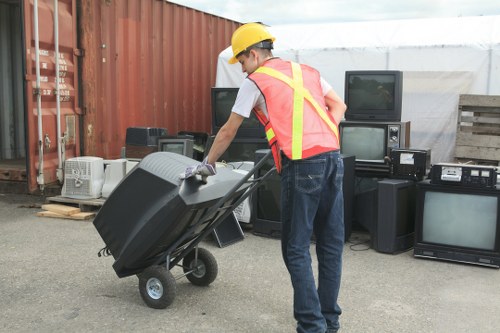Comprehensive Guide to Site Clearance in Staines

Site clearance in Staines is a crucial first step in any construction or renovation project. Whether you're preparing land for new builds, renovating an existing structure, or clearing out a property for redevelopment, understanding the process and requirements is essential for a smooth and efficient project.
Staines, located in Surrey, offers a unique mix of urban and rural environments, making site clearance both a straightforward and complex task. The area's specific regulations and environmental considerations must be taken into account to ensure compliance and minimize disruption.
In this article, we'll explore the key aspects of site clearance in Staines, including planning, execution, and best practices to ensure your project is successful.

The Importance of Professional Site Clearance
Engaging professional services for site clearance ensures that the job is done efficiently and safely. Professionals are equipped with the right tools and expertise to handle various challenges that may arise during the clearance process.
Here are some reasons why hiring professionals for site clearance in Staines is beneficial:
- Safety: Professionals are trained to handle hazardous materials and heavy machinery, reducing the risk of accidents.
- Efficiency: Experienced teams can complete clearance tasks more quickly, saving you time and money.
- Compliance: Professionals are knowledgeable about local regulations and ensure that your project complies with all legal requirements.
- Environmental Responsibility: Experts can manage waste disposal responsibly, minimizing the environmental impact of your project.

Steps Involved in Site Clearance
Site clearance is a multi-step process that requires meticulous planning and execution. Below are the primary steps involved in clearing a site in Staines:
- Assessment and Planning: Conduct a thorough assessment of the site to identify existing structures, vegetation, and potential hazards. Develop a detailed plan outlining the clearance process.
- Obtaining Permits: Ensure all necessary permits and permissions are acquired from local authorities before commencing work.
- Demolition: Safely demolish any existing buildings or structures, using appropriate equipment and techniques.
- Removal of Debris: Clear away rubble, debris, and other waste materials, ensuring proper disposal and recycling where possible.
- Site Preparation: Prepare the cleared site for construction or other intended uses, which may include leveling the ground and addressing any soil issues.
Each step requires careful consideration to ensure that the site is cleared effectively and responsibly.

Assessment and Planning
The first step in site clearance is a comprehensive assessment of the property. This involves identifying any existing structures that need to be demolished, assessing the condition of the landscape, and determining the presence of any hazardous materials such as asbestos.
Proper planning is essential to avoid unexpected delays and cost overruns. During this phase, it's important to:
- Survey the land to understand the topography and existing features.
- Identify any protected species or environmental features that need to be preserved.
- Create a timeline for the clearance process, ensuring that each phase is scheduled efficiently.
By investing time in the assessment and planning stage, you set the foundation for a successful site clearance project.

Obtaining Necessary Permits
Before any physical work begins, it’s crucial to secure the appropriate permits from local authorities in Staines. These permits ensure that the site clearance complies with zoning laws, environmental regulations, and building codes.
To obtain the necessary permits:
- Contact the Staines local council to understand the specific requirements for your project.
- Submit detailed plans and documentation outlining the scope of work.
- Ensure that all environmental impact assessments are completed and approved.
- Pay any applicable fees associated with the permit applications.
Failing to obtain the required permits can result in legal complications, fines, and potential project delays.

Environmental Considerations
Site clearance in Staines must take into account various environmental factors to minimize the impact on the local ecosystem. Sustainable practices not only protect the environment but can also enhance the reputation of your project.
Key environmental considerations include:
- Waste Management: Implementing effective waste management strategies to recycle and dispose of materials responsibly.
- Habitat Preservation: Protecting local wildlife habitats and biodiversity during the clearance process.
- Soil and Water Protection: Preventing soil erosion and protecting water sources from contamination.
- Energy Efficiency: Utilizing energy-efficient machinery and practices to reduce the carbon footprint of your project.

Choosing the Right Site Clearance Service
Selecting a reputable site clearance service in Staines is vital to the success of your project. Here are some factors to consider when choosing a provider:
- Experience: Look for companies with a proven track record in site clearance and relevant experience in the Staines area.
- Licensing and Insurance: Ensure that the service provider holds the necessary licenses and insurance to protect against potential liabilities.
- Equipment: Verify that the company uses modern and well-maintained equipment to handle various clearance tasks efficiently.
- Environmental Compliance: Choose a company committed to sustainable practices and compliance with environmental regulations.
- References and Reviews: Check testimonials and reviews from previous clients to gauge the company's reliability and quality of work.
Taking the time to research and select the right site clearance service can save you time, money, and potential headaches down the line.

Safety Protocols in Site Clearance
Safety is paramount during site clearance operations. Adhering to strict safety protocols protects workers, the public, and the environment.
Essential safety measures include:
- Personal Protective Equipment (PPE): Ensuring all workers wear appropriate PPE, such as helmets, gloves, and safety goggles.
- Hazard Identification: Regularly inspecting the site for potential hazards and mitigating risks promptly.
- Proper Training: Providing comprehensive training for all personnel on the use of equipment and safety procedures.
- Emergency Procedures: Establishing clear protocols for responding to accidents or emergencies.
- Signage and Barriers: Using signs and physical barriers to restrict access to dangerous areas.
By maintaining high safety standards, you ensure that the site clearance process proceeds without unnecessary incidents.

Cost Factors in Site Clearance
Understanding the cost factors involved in site clearance helps in budgeting and avoiding unexpected expenses. Several elements influence the overall cost of the clearance process:
- Site Size and Complexity: Larger and more complex sites require more time and resources, increasing costs.
- Type of Materials: The presence of hazardous materials, such as asbestos, can add to the cost due to the need for specialized removal and disposal.
- Access and Location: Difficult-to-access sites or those in congested areas may require additional equipment or man-hours.
- Permitting Fees: Costs associated with obtaining necessary permits and complying with regulations.
- Waste Disposal: Expenses related to the removal and proper disposal of debris and materials.
Obtaining detailed quotes from multiple service providers can help you compare costs and choose the best option for your budget.

Timeline for Site Clearance Projects
Establishing a realistic timeline is essential for managing a site clearance project effectively. Several factors can influence the duration of the clearance process:
- Project Scope: The complexity and size of the project determine how long each phase will take.
- Weather Conditions: Adverse weather can lead to delays, especially in outdoor clearance tasks.
- Regulatory Approvals: Obtaining necessary permits and approvals may take additional time.
- Resource Availability: The availability of equipment and manpower can impact the project timeline.
- Unexpected Challenges: Unforeseen issues, such as hidden structural problems or environmental concerns, can extend the project duration.
To create an effective timeline:
- Consult with your site clearance provider to understand the estimated time for each project phase.
- Allow buffer time for potential delays.
- Regularly monitor progress and adjust the schedule as needed.
Proper planning and flexibility can help ensure that your site clearance project stays on track.

Post-Clearance Site Preparation
After the site has been cleared, the next step is preparing the land for its intended use. This phase is critical for laying a solid foundation for construction or other projects.
Key activities in site preparation include:
- Ground Leveling: Ensuring the land is even and suitable for building.
- Soil Testing: Assessing soil quality to determine if any amendments are needed.
- Drainage Solutions: Installing systems to manage water runoff and prevent flooding.
- Utilities Installation: Setting up necessary utilities such as electricity, water, and sewage systems.
Effective site preparation sets the stage for a successful construction or redevelopment project, minimizing future issues and ensuring durability.

Common Challenges in Site Clearance
Site clearance projects can encounter various challenges that require careful management to ensure success.
- Unforeseen Obstacles: Hidden structures or underground utilities can complicate the clearance process.
- Environmental Restrictions: Protecting local wildlife and natural resources may limit certain clearance activities.
- Weather Conditions: Inclement weather can delay work and affect project timelines.
- Regulatory Compliance: Navigating complex regulations and obtaining necessary permits can be time-consuming.
- Budget Constraints: Unexpected costs can strain the project budget, requiring adjustments to the plan.
Addressing these challenges proactively through thorough planning and collaboration with experienced professionals can help mitigate risks and keep the project on track.

Benefits of Proper Site Clearance
Investing in proper site clearance offers numerous benefits that extend beyond the immediate project scope.
Some of the key benefits include:
- Enhanced Safety: Removing hazardous materials and unstable structures reduces the risk of accidents.
- Improved Project Efficiency: A well-cleared site allows construction to proceed without unnecessary delays.
- Environmental Protection: Responsible clearance practices help preserve the local ecosystem.
- Cost Savings: Efficient clearance can lower overall project costs by reducing delays and avoiding fines.
- Increased Property Value: Properly cleared and prepared land can enhance the value of your property.
These benefits highlight the importance of dedicating adequate time and resources to the site clearance phase of your project.

Case Studies: Successful Site Clearance Projects in Staines
Examining successful site clearance projects in Staines provides valuable insights into best practices and effective strategies.
One notable project involved clearing a 5-acre plot for a new residential development. The site clearance team conducted a thorough environmental assessment, secured all necessary permits, and implemented sustainable waste management practices. The project was completed ahead of schedule, demonstrating the effectiveness of careful planning and professional execution.
Another example is the clearance of an old commercial site for a community park. The team successfully removed outdated structures, restored the natural landscape, and integrated new green spaces. This project not only revitalized the area but also provided a much-needed recreational space for local residents.

Choosing Sustainable Site Clearance Practices
Sustainability is increasingly important in site clearance projects. Adopting eco-friendly practices not only benefits the environment but can also improve your project's reputation and compliance with regulations.
Here are some sustainable site clearance practices to consider:
- Recycling Materials: Recycle as much debris and materials as possible, reducing landfill waste.
- Minimizing Disturbance: Limit the impact on the surrounding environment through careful planning and execution.
- Using Eco-Friendly Equipment: Opt for machinery that has lower emissions and higher energy efficiency.
- Preserving Green Spaces: Protect existing vegetation and incorporate new green areas into the site design.
- Water Conservation: Implement measures to conserve water and prevent contamination during the clearance process.
By prioritizing sustainability, your site clearance project can contribute positively to the environment and set a standard for future developments in Staines.

Legal Considerations in Site Clearance
Navigating the legal aspects of site clearance in Staines is essential to ensure compliance and avoid potential disputes.
Key legal considerations include:
- Zoning Laws: Understanding and adhering to local zoning regulations that dictate land use and development.
- Environmental Regulations: Complying with laws designed to protect the environment, including waste disposal and habitat preservation.
- Building Codes: Ensuring that any demolition or construction work meets the required building standards.
- Property Rights: Respecting property boundaries and obtaining necessary permissions from landowners.
- Health and Safety Laws: Following legal requirements for workplace safety to protect workers and the public.
Consulting with legal professionals and staying informed about relevant legislation can help you navigate these considerations effectively.

Managing Waste and Recycling
Effective waste management is a critical component of site clearance. Properly handling and disposing of waste minimizes environmental impact and ensures compliance with regulations.
- Sorting Waste: Categorize debris into recyclable, reusable, and non-recyclable materials.
- Recycling: Recycle materials such as metal, concrete, and wood to reduce landfill use.
- Safe Disposal: Dispose of hazardous materials, like asbestos, through certified facilities.
- Reducing Waste: Implement strategies to minimize waste generation during the clearance process.
- Documentation: Keep detailed records of waste management practices to demonstrate compliance.
By managing waste responsibly, you contribute to environmental preservation and enhance the sustainability of your project.

Advanced Techniques in Site Clearance
Modern site clearance employs advanced techniques and technologies to improve efficiency, safety, and sustainability.
Some of these techniques include:
- Mechanical Demolition: Utilizing specialized machinery like excavators and bulldozers for efficient demolition.
- High-Reach Excavators: Accessing hard-to-reach areas safely and effectively.
- Dust Control Systems: Minimizing airborne particles to protect workers and the surrounding environment.
- GPS and GIS Mapping: Using mapping technologies to plan and monitor the clearance process.
- Telematics: Monitoring equipment performance and usage to optimize operations.
Incorporating these advanced techniques can significantly enhance the quality and efficiency of your site clearance project.

Innovations in Waste Recycling
Innovations in waste recycling are transforming site clearance by enabling more materials to be reused and reducing the reliance on landfills.
- Material Recovery Facilities (MRFs): Advanced facilities that sort and process mixed waste, increasing the rate of recycling.
- Mobile Recycling Units: Portable units that allow for on-site recycling, reducing transportation costs and emissions.
- Recycling Robots: Automated systems that efficiently sort and separate materials for recycling.
- Biodegradable Materials: Using materials that can decompose naturally, reducing environmental impact.
- Circular Economy Practices: Designing projects to reuse and repurpose materials, minimizing waste generation.
Embracing these innovations can make your site clearance process more sustainable and cost-effective.

Final Thoughts on Site Clearance in Staines
Site clearance is a foundational aspect of any construction or redevelopment project in Staines. By understanding the process, engaging with professional services, and adhering to best practices, you can ensure that your project progresses smoothly and responsibly.
Remember to:
- Conduct thorough assessments and planning.
- Secure all necessary permits and comply with regulations.
- Prioritize safety and environmental sustainability.
- Choose experienced and reputable site clearance providers.
- Implement effective waste management and recycling strategies.
Proper site clearance sets the stage for successful construction, enhances property value, and contributes to the overall development of the Staines community.
Ready to start your site clearance project in Staines? Contact us today to book your service and take the first step towards a successful development.